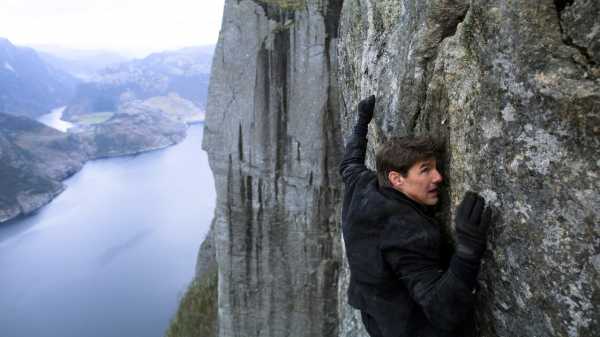
In his 1846 essay “The Present Age,” Søren Kierkegaard decried the widespread tendency of the time—which he summed up as an age “without passion”—to “transform daring and enthusiasm into a feat of skill.” I’m not sure that these observations apply to the modern public at large, but they certainly account in significant measure for the peculiar critical acclaim that “Mission: Impossible—Fallout,” written and directed by Christopher McQuarrie, has been garnering. The film—the sixth in the “Mission: Impossible” series—is intelligently made, but its display of intelligence is an equivocal virtue. Its feat of cinematic engineering invites admiration for its engineering: the infrastructure is on the outside, the seemingly tenuous threads that dangle its dramatic pendants are on view, and the delights that it offers are those of a production video, showcased not in a behind-the-scenes reel but throughout the movie itself.
While viewers are having their sensibilities dunned and stunned by infotainment tales of this movie’s “feat of skill,” the critical community rushes to search for continuity between its cinematic spectacle and the classical era of filmmaking. The widely ballyhooed details of Tom Cruise’s readiness to perform his own dangerous and difficult stunts conjures, to the public, a sense of satisfaction regarding the pains that a fabulously rich and famous person is willing to take for their pleasures; for critics, it evokes an age of artistic heroism harking back to Buster Keaton’s and Harold Lloyd’s self-sacrificing stunts. But the knowledge that Cruise takes the risk of doing his own stunts is insignificant from a cinematic perspective unless he’s filmed in a way that emphasizes his physical commitment—and the production’s dependence on his physical commitment. Instead, there’s little in “Mission: Impossible—Fallout” to suggest that Cruise wasn’t mashed up via C.G.I. with stunt performers onto whose physiques his face and voice were superimposed. To complete the sense of a nostalgia trip for tradition-hungry critics, the movie was shot on 35-mm. film, not digital video. This, too, doesn’t matter at all—there’s hardly a visual sensibility detectible anywhere in the movie, not an image with any resonance or overtone beyond the transparent conveyance of the scripted action.
These action scenes aren’t intimate or precise. They are, by and large, smeary—the idea of their cumulative mechanisms, their plotting, the payoff that results, overrides any single image by which they’re realized. Yet at the same time they’re not filmed with any conspicuous cinematic impressionism or subjective fragmentation. They seem intended, rather, to deliver an illusion of thoroughness, of completeness, of spectacular exhaustiveness, that no individual image suggests on its own. There’s a great deal of tumult and thrashing in the action sequences but little sense of dynamic stillness; here, when there’s no onscreen agitation, there’s merely nothing happening. Nowhere in the movie’s gargantuan churn is there a single moment of astonishing grace to rival Cruise’s cable-dangling backflip in the first “Mission: Impossible,” directed by Brian De Palma.
The intricate plot of “Mission: Impossible—Fallout” has a miniseries-like surplus of twists that are rooted in elaborate deceptions and false identities. The movie’s MacGuffin is a trio of metallic spheres, about the size of bocce balls, that contain plutonium and are adorned with gizmos to plug them catastrophically into detonators. The terroristic villains who seek it sound more like a couple of British Invasion bands—Solomon Lane and the Apostles, John Lark and the Syndicate—but there’s nothing entertaining about their intentions. With the help of a rogue nuclear scientist, they’re planning to commit mass nuclear murder—and Ethan Hunt (Cruise) and his closest associates in the Impossible Missions Force, Benji (Simon Pegg) and Luther (Ving Rhames), stage a meeting with the plutonium-ball sellers but are ambushed.
To save Luther’s life, Ethan lets the villains get away with the plutonium, and the rest of the movie’s two-and-a-half-hour span is devoted to the group’s effort to get them back or to render them inert before the evildoers can detonate them. But, along the way, Ethan comes under suspicion for having let the villains get away with the plutonium; he’s accused by the group’s civilian director (Alec Baldwin) of being in cahoots with them (or worse, being one of them). Also, the group finds itself confronting arms dealers who appear to be helping the villains acquire their nuclear weaponry, notably the White Widow (Vanessa Kirby), who’s also equipped with an uncertain identity and elusive allegiances.
McQuarrie also injects some romantic melancholy into the plot, doing so midway through the film with a quick but telling mention of Ethan’s wife, Julia (Michelle Monaghan). That very mention—of a character who has been unseen throughout—threatens the glimmer of his romance with his colleague Ilsa Faust (Rebecca Ferguson); when she turns up later, she threatens to distract Ethan from his extravagant and delicate duty. Despite the deft coherence of the plot’s mirror games of alliance and betrayal, which provide the illusion of a developed drama, the movie almost totally deprives its characters of inner life or complex motives.
The action sequences that are the “Mission: Impossible” movies’ raisons d’être are at their best, in “Fallout,” when they’re at their simplest—whether in a gory martial-arts-centered battle in a gleaming modern bathroom in Paris’s Grand Palais or in a presto-change-o deceit that’s cribbed from a routine in the first “Mission: Impossible” film. Those scenes, however, are the exceptions. A mighty car chase in Paris is a cold rehash of dozens of similar sequences served up through the decades (a similar scene in the soon-to-be-released comedy “The Spy Who Dumped Me” is much more original and clever); a shoot-out in the shadow of the Paris Métro doesn’t have the clarity to match its rapidity. There’s some quick wit in Ethan’s dash in London’s South Bank toward the Tate Modern, thanks to Benji’s hasty reading of a G.P.S. map, but the action soon devolves into a jumble of picturesque absurdities that exist for the sole purpose of bringing down the curtain on one act and initiating another, the final one.
That concluding routine, already somehow celebrated, involving helicopters above the mountains and crags of Kashmir, is a blustering, mechanical anticlimax, in which the ending is foretold. The airborne sequence is set up by and coördinated with events on the ground, a matched set of last-moment maneuvers and escapes that leaves little surprise in its outcome. Since only a moment or two offers anything like a visceral jolt, let alone a sense of actual physical danger, the action offers the sense of viewing a shoot schedule and a work plan developing through the images onscreen. The problem with constructing a movie as one long making-of sequence is that, if it’s a movie as inert as this one, it doesn’t so much answer the question “How was it made?” as pose another one altogether: Why?
Sourse: newyorker.com






